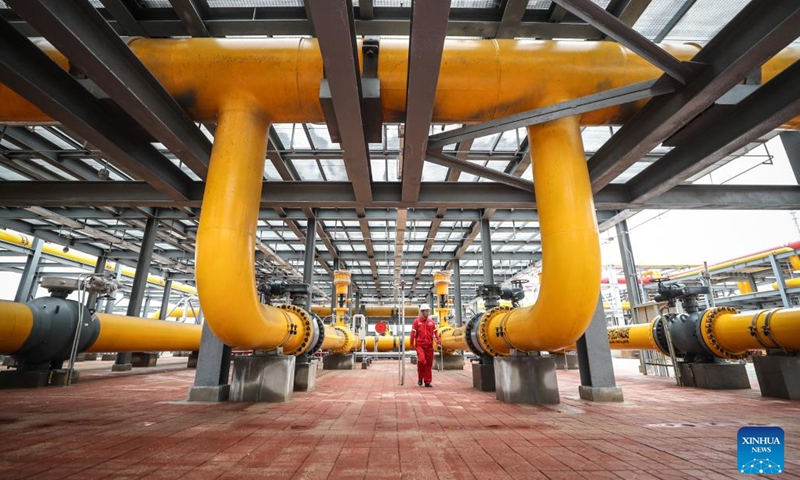
A staff member inspects at the Shuangtaizi gas storage area of PetroChina Liaohe Oilfield gas storage group in Panjin, northeast China's Liaoning Province, June 15, 2022. The homebred gas injection system was successfully put into operation here in late May, and the overall daily gas injection capacity of Liaohe gas storage group increased from 14 million cubic meters to 30 million cubic meters.(Photo: Xinhua)
China's two oil giants, PetroChina and China National Offshore Oil Corporation (CNOOC), have reported record-high first-half profit amid stratospheric global oil prices, with total profits hitting 150 billion yuan ($21.85 billion), inching close to their whole-year profits for 2021.
According to PetroChina's financial report released on Thursday, the company's revenue in the first half of 2022 grew by 34.9 percent year-on-year to 1.61 trillion yuan, with profit during the same period climbing up by 55.3 percent year-on-year to 82.39 billion yuan.
The company's output of oil and gas equivalents in China in the first half was 103.32 million tons, gaining 3.9 percent year-on-year, with crude oil output in China reaching 52.47 million tons, up 3.4 percent year-on-year, the financial report showed.
Over the first half of 2022, CNOOC also saw a drastic jump in both revenue and profits to 176.7 billion yuan and 71.89 billion yuan, up 75.6 percent and 115.7 percent, respectively, according to its financial report released on Thursday.
With a number of new oilfields put into operation, CNOOC's oil output climbed 8 percent in the first half, and its natural gas output rose 16 percent, as its "Deep Sea No.1," China's independently developed ultra-deepwater gas field, was put into production and the productivity of onshore unconventional natural gas improved.
Industry observers said that it is vitally important for China's major energy producers to scale up production and supply of oil and natural gas amid global market fluctuations and an uncertain external environment, so as to ensure China's energy security.
Ren Lixin, senior vice president of PetroChina, predicted that the oil price will return to reasonable range over the long term as global economy reverts to more balanced growth. Ren explained that demand for crude oil has missed expectations due to the pandemic and global economic slowdown, while there's also uncertainty impacting the supply side.
At the press briefing addressing PetroChina's first-half financial report, Wang Hua, chief financial officer of the company, also elaborated on the reasons behind the oil giant's delisting from US stock market, including "a very small proportion of American Depositary shares in its total shares and Hong Kong-listed shares, as well as a relatively high administrative cost due to regulatory difference between the two sides."
Wang also said that after the US delisting, the company's stocks will continue trading on the Hong Kong and Shanghai bourses, which will meet the demands for both fundraising and investing.
Sinopec, one of China's "big three" oil giants, is set to report its first-half results on Monday.
The company set up a national-level shale oil demonstration area in the Shengli Oilfield in East China's Shandong Province on Thursday, the third of such kind in China, news website jiemian.com reported on Friday.
It is expected that by the end of the 14th Five-year period (2021-25), the Shengli Oilfield will realize a proved reserve of 100 million tons of shale oil, with an annual output of 500,000 tons and a new capacity of 1 million tons.
Global Times




